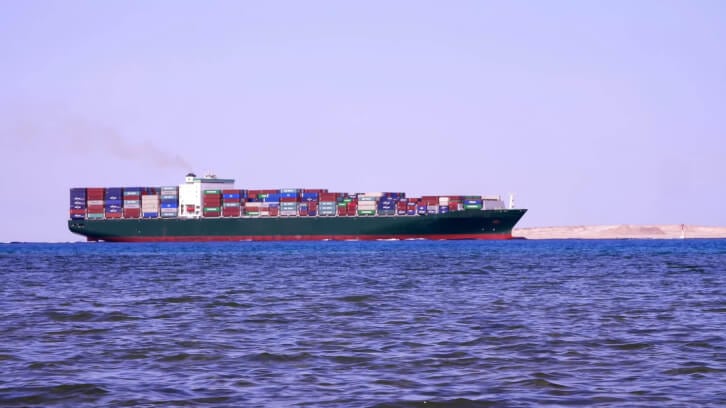Trade routes and raw materials
Disruptions in the Black Sea as a result of Russia's invasion on Ukraine and climate-induced droughts in the Panama Canal have been followed by the effects of Red Sea crisis.
In both the Suez and Panama canals, transits are down by more than 40% compared to their peaks, dad from UNCTAD found.
Last year, an estimated 22% of global seaborne container trade passed through the Suez Canal, which enables a direct route between Europe and Asia - opposed to navigating around the African continent.
Consequently, shipping times have been extended significantly and costs increased, as many ships have opted for the safer but longer route around The Cape of Hope. UNCTAD data found that by the first half of February 2024, more than 500 container vessels had been rerouted, while container tonnage crossing the canal fell by 82%.
In fact, container prices shot up by 300%, Ian Wright, partner at Acuti Associates revealed during the Food Manufacture roundtable - click here to watch in full (see snippet below for teaser).
The Panama Canal - crucial for countries on the West Coast of South America - has been witnessing low water levels, with daily transits forced to drop. Prior to the Red Sea crisis, ships had been rerouted through the Suez Canal - an option which is now not possible.
While supply chains have been disrupted, the impact on the UK’s food and drink supply has not been quite as dramatic as some headlines would make you think.
“At the Food & Drink Federation (fdf) we haven’t heard too much around disruptions. A handful of members are saying that they are trying to build stocks, mainly in the condiments sector, but this is more as a contingency to ensure they maintain business as usual,” stated Liliana Danila, lead economist at the fdf.
“We are running a quarterly survey, the last one [January] saw most members talking of stabilised business conditions, with relatively lower volatility compared to half a year ago.”
According to Rod Addy, director general at the Provision Trade Federation (PTF), it’s a similar story from the PTF’s members: “Disruption is thankfully not as quite as great as some media suggests.”
He went onto say that for the suppliers it is impacting, it’s mostly hitting those looking further afield (outside of the UK) and several have been considering alternative sourcing solutions.
Prices
Whilst Danila reassured there aren’t any commodities to be concerned about in terms of availability (yes, Brits will still get their cuppa), we have been seeing raw material prices on the rise as a result of two major reasons.
“One of the biggest impacted has been cocoa, where prices have more than doubled, reaching an all-time high since the 70s,” she explained.
“The main producers, which are Cote d’Ivoire and Ghana, have seen very bad weather and much wetter conditions than usual. But that also comes off the back of a persistent decline in investment in those countries. The combination of these two factors have led to very small output this year.
“For the last two years, we have also been seeing olive prices rising. They are 50% higher compared to two years ago. This is also a result of weather conditions, with extreme droughts in Spain, Italy and Greece.”
UK inflation is easing though, with January reaching 7% for food and non-alcoholic drinks – the lowest it’s been since April 2022.
“We expect that to continue but problems nevertheless remain,” Danila said. “According to the ONS, January saw overall producer costs dipping year-on-year, 0.9% lower. With domestic ingredients about 2% lower. But when we look at imported ingredients, inflationary pressures remain. They were 4.5% higher on the year in January.”
She continued: “When you look at volumes of sales for food retail, these have been in decline for about two years. In December 2023 volume of sales of food in supermarkets were about 5% lower than they were in December 2019. The cost-of-living crisis has definitely bought in a lower consumption of food. Whether we have ‘turned a corner’ remains to be seen.”
The food industry is also facing higher rates of vacancies, compared to the UK manufacturing sector as a whole.
“Our members are reporting labour shortages across the board, from low skilled workers to highly skilled specialists. In April, we are going to see the National Living Wage increase by 9.8% against this backdrop,” Danila added.
Global trade and UK investment
One of the primary reasons for the labour gap is arguably Brexit red tape, with further pressure coming from constant U-turns and postponements by UK Government.
This has left the industry feeling, well, rather confused – and quite understandably.
“When we exited the EU, it was clear that there wasn’t a coherent plan that could be put in place immediately,” Addy said. “There was certain amount of policy done on the hoof…but to be fair, the Government is facing a lot of headwinds.”
Since the referendum in 2016 and the UK’s official exit of the EU four years later, the Government has adapted its policies to a certain extent – stating it will not comprise on the UK’s high food safety standards, but this has, as Addy admitted, “made it more difficult to forge free trade agreements”.
“One of the major problems over the last few years has been a lack of clarity around regulation,” he continued. “The way the Government operates tends to be more in silos, which slows things down.
“The U-turn often happens too late, when money has been invested and could have been used elsewhere.
“It does emphasise the importance of communication and collaboration – better working between Government and its departments.”
Against the whirlwind of challenges, conversation around a nationalised food system has been bubbling away.
As Eric Geling, TNA’s chief sales officer said during the session: “There has been a realisation that we have become too dependent on a globalised world.”
And against the looming, potential change of leaders across the world – from the UK, to India, to the States, Geling said Britain needs to make sure (whoever comes into power) it continues to “weight imports vs local production in a fair way”.
Addy added to this: “We need to have, at government level, a coherent plan for the food chain that is UK wide that is not focused purely on the devolved administrations and in tandem with UK-wide food policy, we should have an international food strategy.
“A plan for our development that takes into account how much we need to rely on imports and how much we need to produce domestically.
“We need to look at investing in domestic production and to shore up domestic production. But we have to recognise we can't supply everything that we need in this country and so we have to find better ways of forging deals and reliance on overseas supply.”
Moving forwards
All things considered, the UK’s food and drink sector is handling things well; and Wright believes this is down to the industry’s ability to adapt more quickly.
“That has to be a consequence of the lessons learned during the COVID crisis [and] to a lesser extent, the disruption caused by the initial impact of Brexit,” Wright surmised.
However, we aren’t out of the woods yet. As the panel referenced towards the conclusion of the session, this period instability is not going anywhere.
“We’re in for at least a decade of instability,” Addy predicted, whilst Wright said it would probably be even longer than that.
For things to move forward, Addy believes technology needs to be at the forefront – and he is certain that this period could be one where we see another leap forward in tech.
The kind of technology Addy is referring to includes that which measure and forecast metrics in real-time, including climate change impact, disease spread, pricing impact, trade flow, etc.
“There are always winners and there are always opportunities – and we need to look for those opportunities,” he noted.
Moreover, with the raft of sustainability regulation coming into effect, producers will be forced to embrace such technology whether they like it or not.
Geling held similar thoughts to Addy: “These newer initiatives suddenly make more sense!”
He believes higher prices can be countered through long-term solutions that offer efficiency in ingredients use, energy, waste and so on.
Wright agreed keeping an eye on the future was key, with businesses needing to consider everything that could happen and what they need to do if it does.
Watch our exclusive roundtable, available for three months for free, here: How to minimise disruption in an uncertain climate. You may also be interested in reading our exclusive article on how to finance the future of food.





